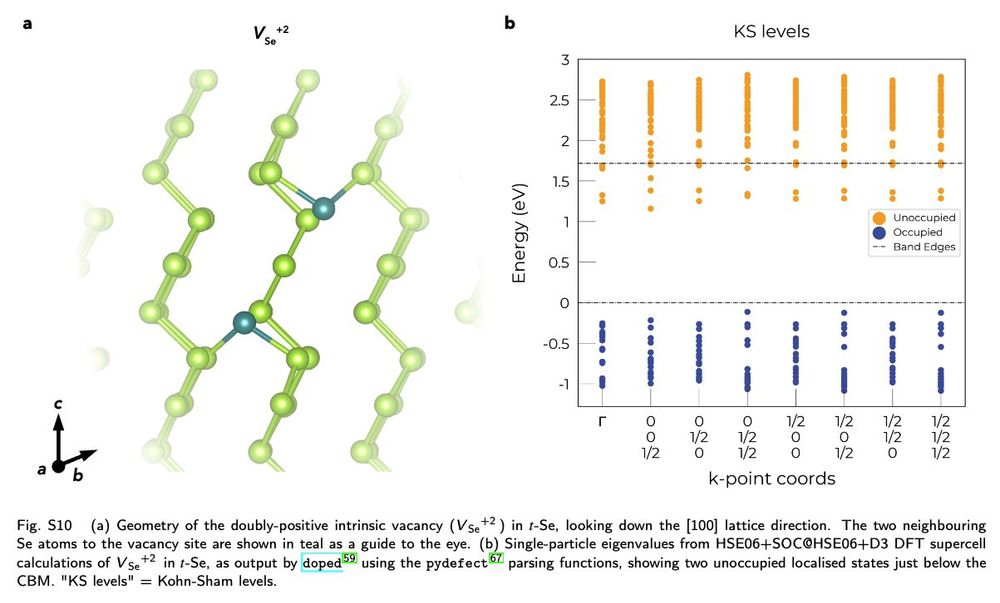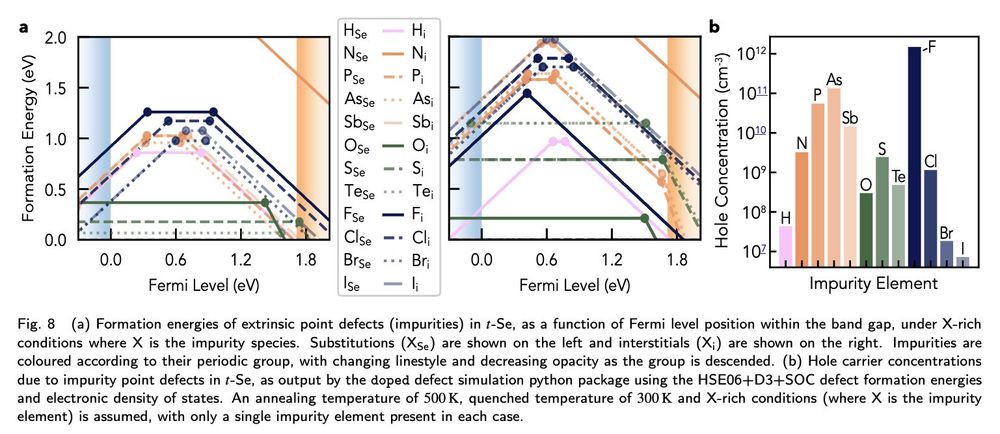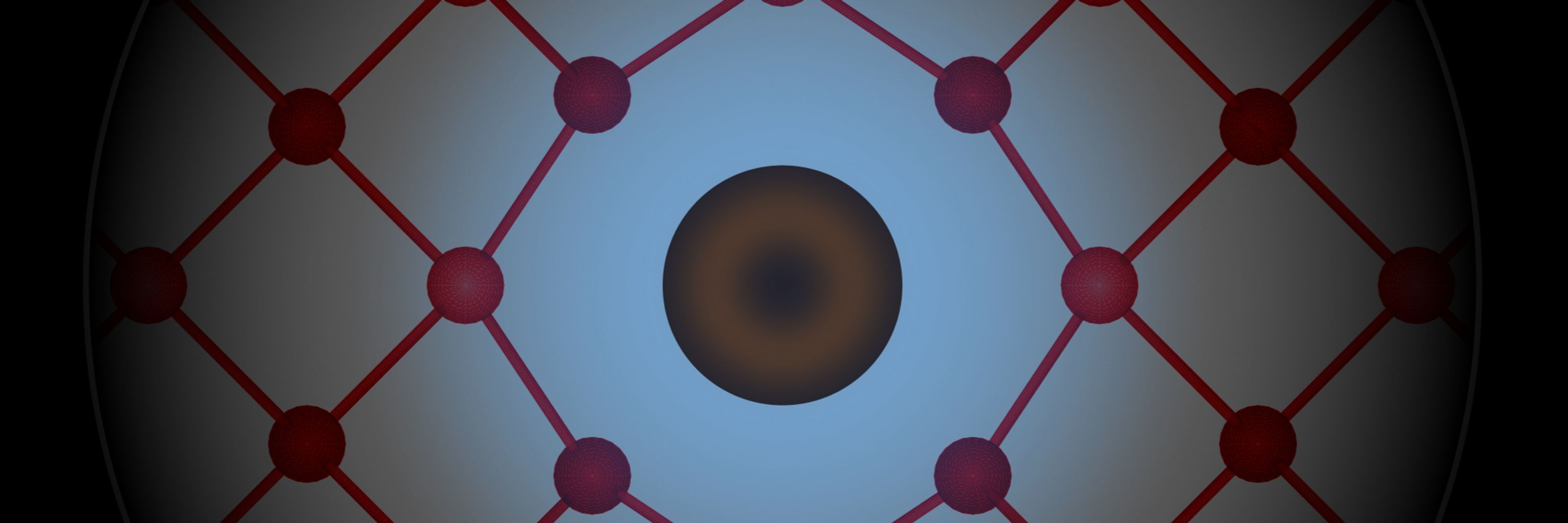
Seán Kavanagh
@kavanaghsean.bsky.social
https://sam-lab.net
Computational chemist, physicist, material scientist? Who knows...
Asst Prof in Simulation of Energy Materials at the University of Cambridge (Chemistry)
Formerly Environmental Fellow @harvard.edu
Computational chemist, physicist, material scientist? Who knows...
Asst Prof in Simulation of Energy Materials at the University of Cambridge (Chemistry)
Formerly Environmental Fellow @harvard.edu
I will be joining the University of Cambridge as an Assistant Professor in the Yusuf Hamied Department of Chemistry! 🧪🎉
𝐈 𝐚𝐦 𝐚𝐜𝐭𝐢𝐯𝐞𝐥𝐲 𝐫𝐞𝐜𝐫𝐮𝐢𝐭𝐢𝐧𝐠 𝐬𝐭𝐮𝐝𝐞𝐧𝐭𝐬, and am very keen to support fellowship applications – visit our website for details! ⬇️
𝐈 𝐚𝐦 𝐚𝐜𝐭𝐢𝐯𝐞𝐥𝐲 𝐫𝐞𝐜𝐫𝐮𝐢𝐭𝐢𝐧𝐠 𝐬𝐭𝐮𝐝𝐞𝐧𝐭𝐬, and am very keen to support fellowship applications – visit our website for details! ⬇️

September 11, 2025 at 2:27 PM
I will be joining the University of Cambridge as an Assistant Professor in the Yusuf Hamied Department of Chemistry! 🧪🎉
𝐈 𝐚𝐦 𝐚𝐜𝐭𝐢𝐯𝐞𝐥𝐲 𝐫𝐞𝐜𝐫𝐮𝐢𝐭𝐢𝐧𝐠 𝐬𝐭𝐮𝐝𝐞𝐧𝐭𝐬, and am very keen to support fellowship applications – visit our website for details! ⬇️
𝐈 𝐚𝐦 𝐚𝐜𝐭𝐢𝐯𝐞𝐥𝐲 𝐫𝐞𝐜𝐫𝐮𝐢𝐭𝐢𝐧𝐠 𝐬𝐭𝐮𝐝𝐞𝐧𝐭𝐬, and am very keen to support fellowship applications – visit our website for details! ⬇️
This allows an efficient tiered screening; scanning 𝘢𝘭𝘭 compounds in the ICSD & Materials Project database for split cation vacancies

July 15, 2025 at 1:40 PM
This allows an efficient tiered screening; scanning 𝘢𝘭𝘭 compounds in the ICSD & Materials Project database for split cation vacancies
We can't just enumerate all potential split vacancy configurations; the search space is enormous (>1000s of candidate geometries per defect). I find instead that electrostatic models can greatly reduce this space, as electrostatics dominate energetics for these 'stoichiometry-conserving' complexes
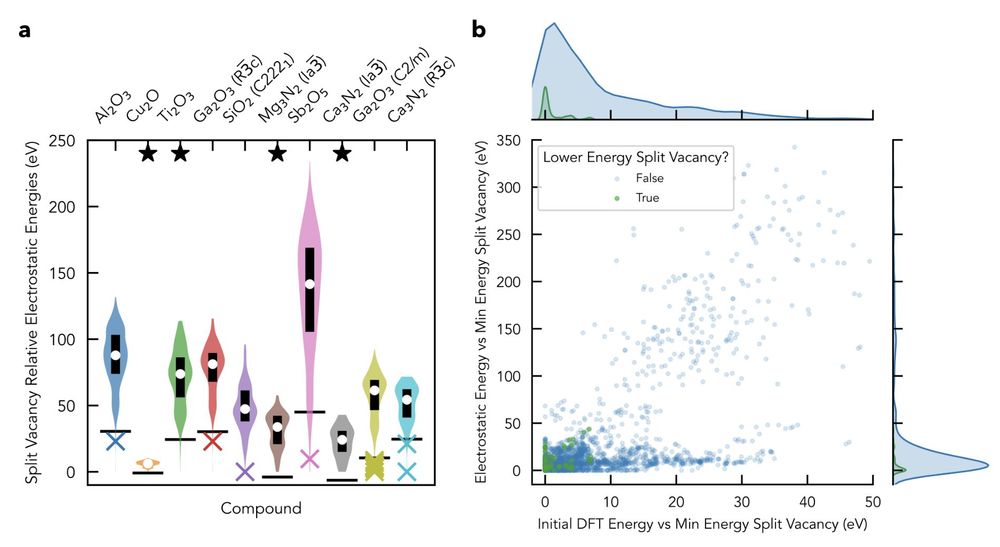

July 15, 2025 at 1:40 PM
We can't just enumerate all potential split vacancy configurations; the search space is enormous (>1000s of candidate geometries per defect). I find instead that electrostatic models can greatly reduce this space, as electrostatics dominate energetics for these 'stoichiometry-conserving' complexes
Vacancy defects can sometimes transform to split-vacancies, with dramatic changes in energy & behaviour, e.g. in Ga₂O₃ as discovered by Joel Varley. They have only been witnessed in a handful of cases – are they inherently rare or have we just not had the tools to find them?
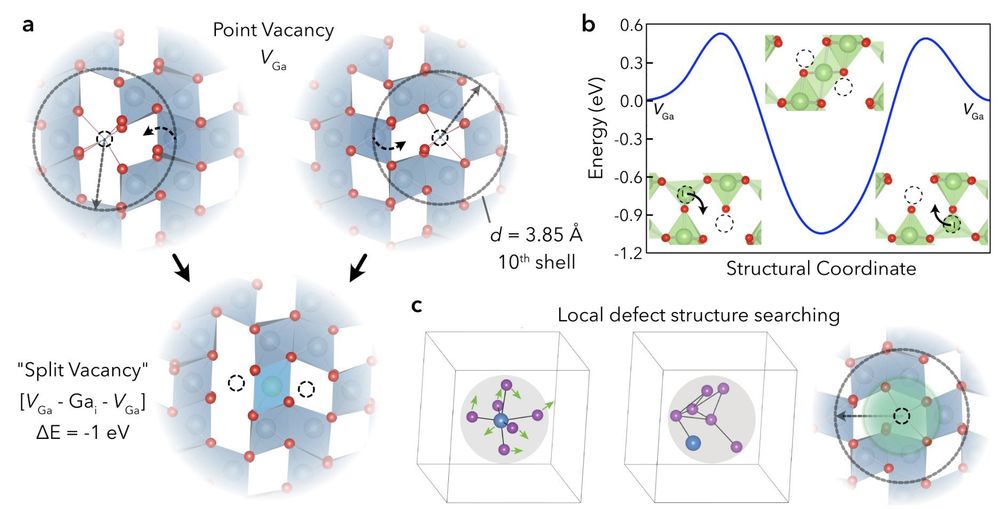
July 15, 2025 at 1:40 PM
Vacancy defects can sometimes transform to split-vacancies, with dramatic changes in energy & behaviour, e.g. in Ga₂O₃ as discovered by Joel Varley. They have only been witnessed in a handful of cases – are they inherently rare or have we just not had the tools to find them?
Machine learning can be powerful for modelling defects, but currently only in select cases.
MLIPs (& geometric/electrostatic tools in doped) allow screening for challenging 'non-local' defect reconstructions (split vacancies) in all ICSD/MP solids, w/caveats
iopscience.iop.org/article/10.1...
MLIPs (& geometric/electrostatic tools in doped) allow screening for challenging 'non-local' defect reconstructions (split vacancies) in all ICSD/MP solids, w/caveats
iopscience.iop.org/article/10.1...

July 15, 2025 at 1:40 PM
Machine learning can be powerful for modelling defects, but currently only in select cases.
MLIPs (& geometric/electrostatic tools in doped) allow screening for challenging 'non-local' defect reconstructions (split vacancies) in all ICSD/MP solids, w/caveats
iopscience.iop.org/article/10.1...
MLIPs (& geometric/electrostatic tools in doped) allow screening for challenging 'non-local' defect reconstructions (split vacancies) in all ICSD/MP solids, w/caveats
iopscience.iop.org/article/10.1...
Available on the development branches;
- Complex defect multiplicities, symmetries and degeneracies
- N-dimensional chemical potential heatmap plotting using fixed values (to reduce to 3-D)
- Defect "stenciling" to regenerate (relaxed) geometries in arbitrary supercells...
- Complex defect multiplicities, symmetries and degeneracies
- N-dimensional chemical potential heatmap plotting using fixed values (to reduce to 3-D)
- Defect "stenciling" to regenerate (relaxed) geometries in arbitrary supercells...

June 18, 2025 at 1:07 PM
Available on the development branches;
- Complex defect multiplicities, symmetries and degeneracies
- N-dimensional chemical potential heatmap plotting using fixed values (to reduce to 3-D)
- Defect "stenciling" to regenerate (relaxed) geometries in arbitrary supercells...
- Complex defect multiplicities, symmetries and degeneracies
- N-dimensional chemical potential heatmap plotting using fixed values (to reduce to 3-D)
- Defect "stenciling" to regenerate (relaxed) geometries in arbitrary supercells...
We find a high sensitivity of the band edges to lattice parameters (i.e. deformation potentials) in t-Se, which combined with v low elastic constants (vdW-bonded) indicates significant thermal fluctuations and strain effects

April 15, 2025 at 1:25 PM
We find a high sensitivity of the band edges to lattice parameters (i.e. deformation potentials) in t-Se, which combined with v low elastic constants (vdW-bonded) indicates significant thermal fluctuations and strain effects
doped automatically outputs dataframes/tables to aid reproducibility (and reduce manual efforts), showing all contributions to formation energies, estimated charge correction errors, symmetries, degeneracies etc
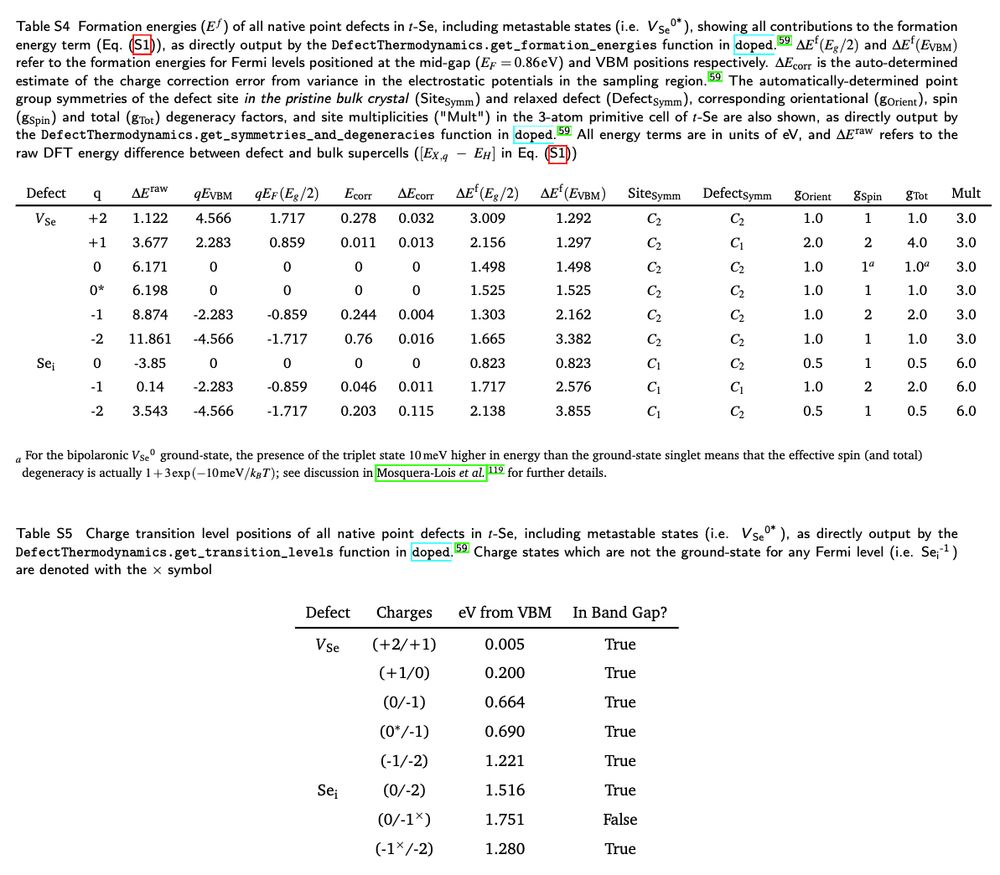
April 15, 2025 at 1:25 PM
doped automatically outputs dataframes/tables to aid reproducibility (and reduce manual efforts), showing all contributions to formation energies, estimated charge correction errors, symmetries, degeneracies etc
In particular, we find many energy-lowering reconstructions of defect geometries using ShakeNBreak, which are missed by standard/rattled relaxations (incl the V_Se^0 bipolaron mentioned above).
Full details in the SI for full reproducibility 🤝
Full details in the SI for full reproducibility 🤝
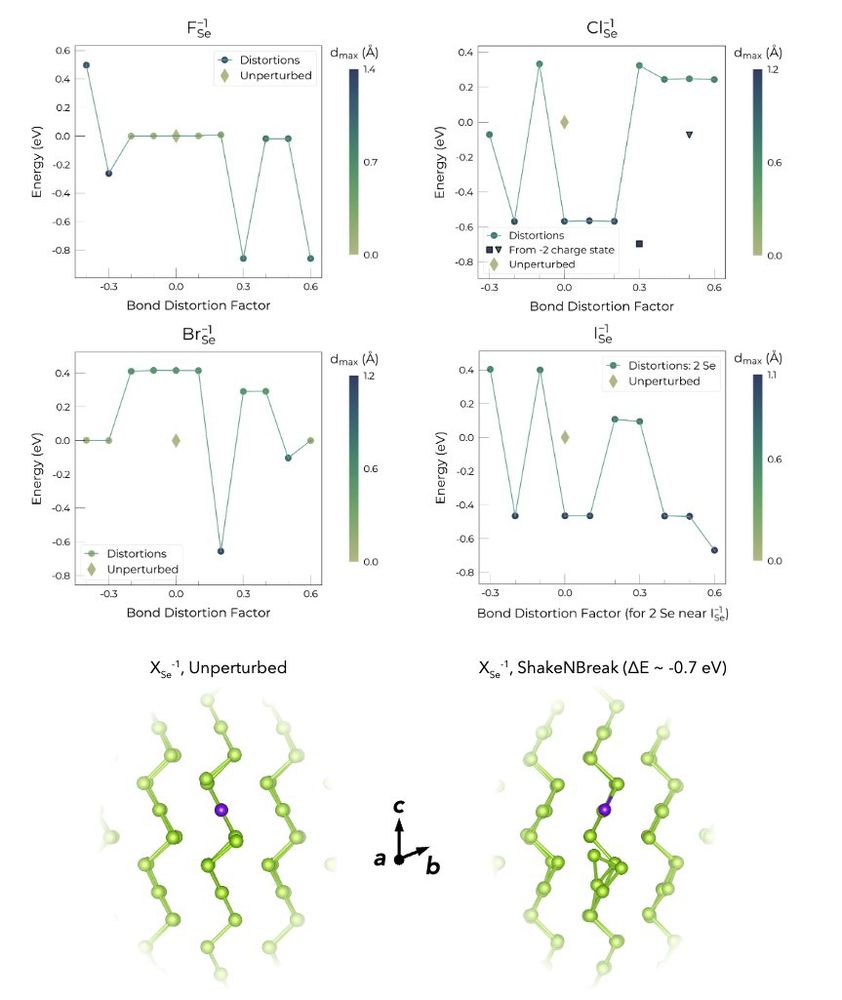
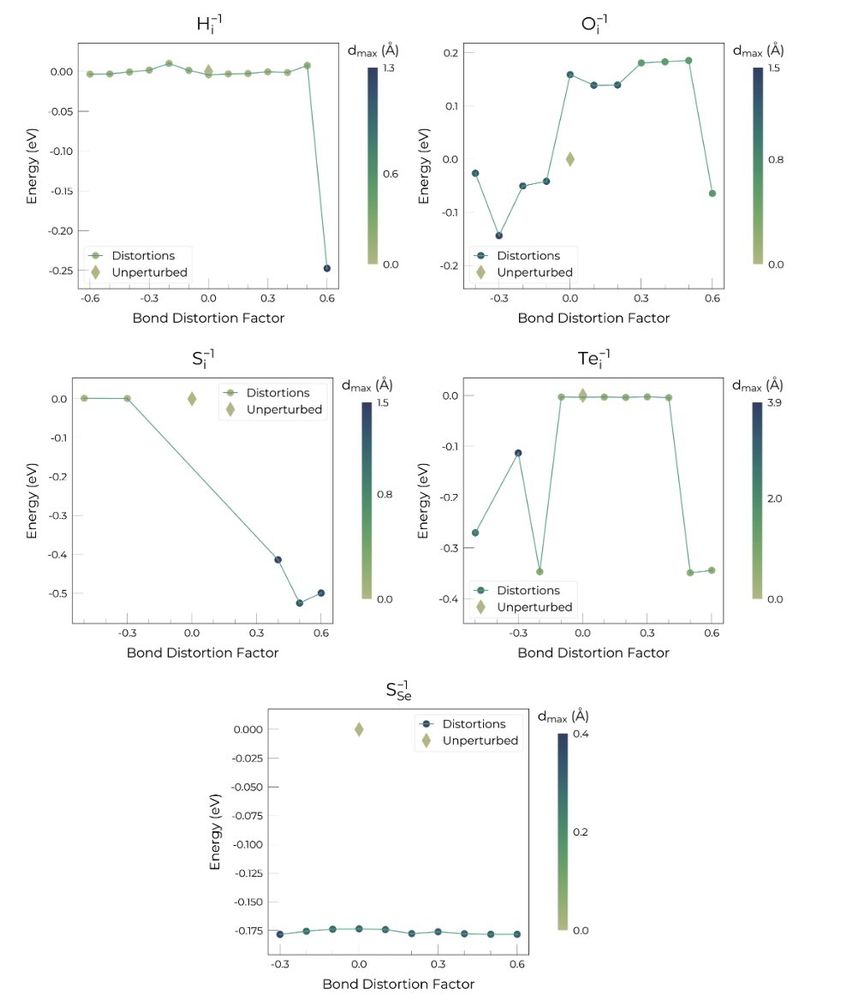
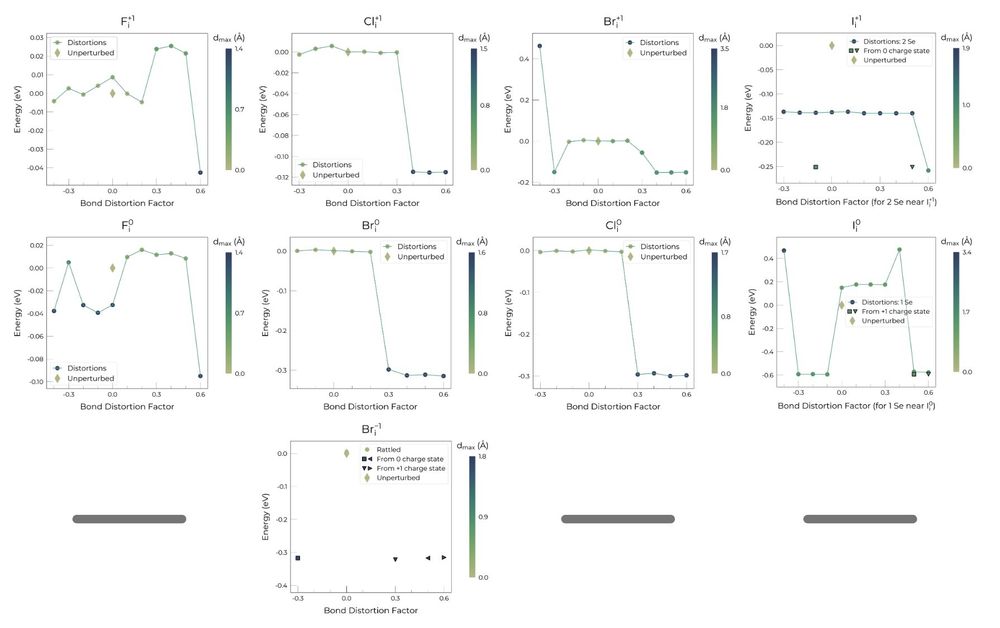
April 15, 2025 at 1:25 PM
In particular, we find many energy-lowering reconstructions of defect geometries using ShakeNBreak, which are missed by standard/rattled relaxations (incl the V_Se^0 bipolaron mentioned above).
Full details in the SI for full reproducibility 🤝
Full details in the SI for full reproducibility 🤝
Calculating impurity formation energies (w/doped & SnB), we find strong valence alternation -> amphoteric & charge compensation for H, pnictogens & halogens. Chalcogens are electrically neutral.
F contributes the strongest to hole doping, but still relatively weak (~10¹² cm³)
F contributes the strongest to hole doping, but still relatively weak (~10¹² cm³)
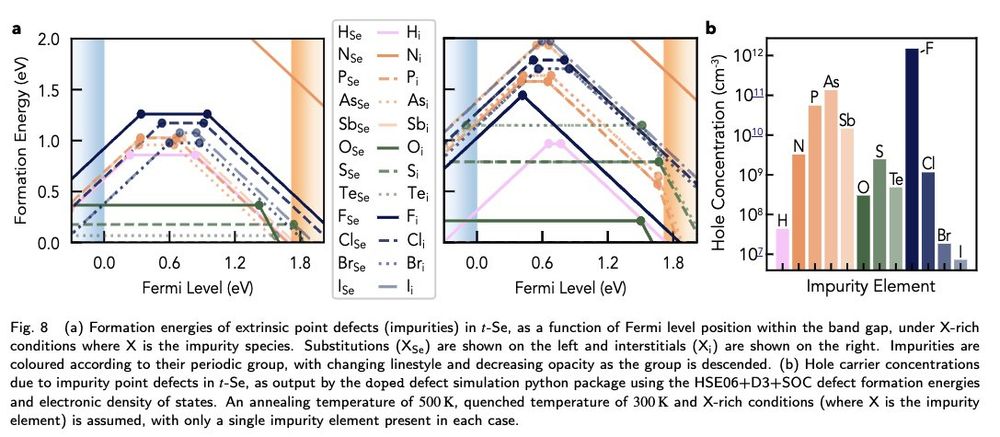
April 15, 2025 at 1:25 PM
Calculating impurity formation energies (w/doped & SnB), we find strong valence alternation -> amphoteric & charge compensation for H, pnictogens & halogens. Chalcogens are electrically neutral.
F contributes the strongest to hole doping, but still relatively weak (~10¹² cm³)
F contributes the strongest to hole doping, but still relatively weak (~10¹² cm³)
With ToF-SIMS analysis of high-quality Se films, we show that F, Cl, O and Te are present in the samples, mainly from precursors used.
O and Te are mainly at the surfaces/interfaces.
Br & I are also expected but the Se/Te isotopes prevent direct identification.
O and Te are mainly at the surfaces/interfaces.
Br & I are also expected but the Se/Te isotopes prevent direct identification.
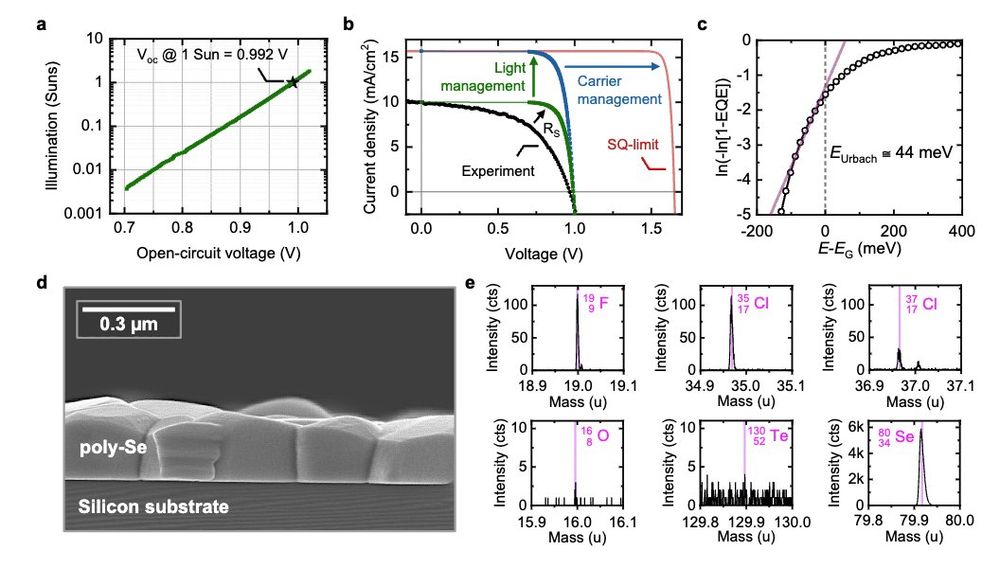
April 15, 2025 at 1:25 PM
With ToF-SIMS analysis of high-quality Se films, we show that F, Cl, O and Te are present in the samples, mainly from precursors used.
O and Te are mainly at the surfaces/interfaces.
Br & I are also expected but the Se/Te isotopes prevent direct identification.
O and Te are mainly at the surfaces/interfaces.
Br & I are also expected but the Se/Te isotopes prevent direct identification.
Calculating the non-radiative recombination rates of the intrinsic point defects, we find that they 𝘢𝘳𝘦 𝘯𝘰𝘵 fast capture centres and thus do 𝘯𝘰𝘵 limit performance in Selenium PV.
They also do not contribute significantly to hole doping...
So what else could it be?
They also do not contribute significantly to hole doping...
So what else could it be?

April 15, 2025 at 1:25 PM
Calculating the non-radiative recombination rates of the intrinsic point defects, we find that they 𝘢𝘳𝘦 𝘯𝘰𝘵 fast capture centres and thus do 𝘯𝘰𝘵 limit performance in Selenium PV.
They also do not contribute significantly to hole doping...
So what else could it be?
They also do not contribute significantly to hole doping...
So what else could it be?
A bipolaron metastable state is found for the neutral vacancy (using ShakeNBreak), only 27 meV higher energy (depending on its spin configuration).
The V_Se geometries are driven by valence alternation (Kastner et al. PRL 1976; see SI), with Se inter-chain bonds / terminations
The V_Se geometries are driven by valence alternation (Kastner et al. PRL 1976; see SI), with Se inter-chain bonds / terminations
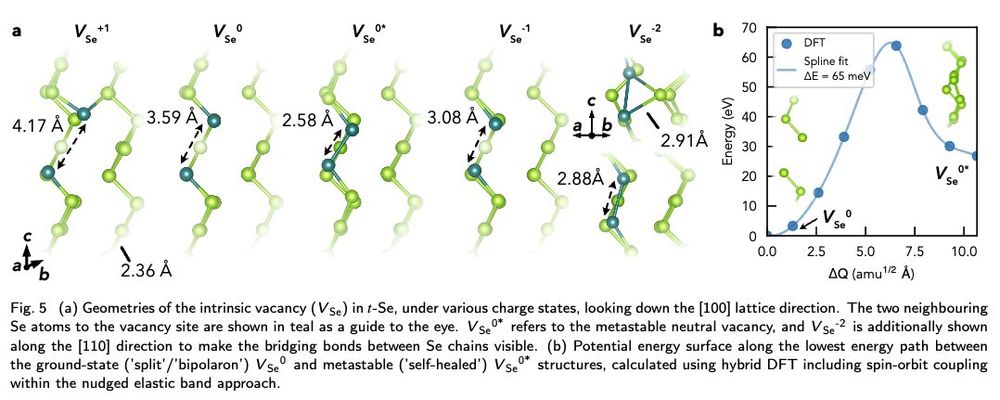
April 15, 2025 at 1:25 PM
A bipolaron metastable state is found for the neutral vacancy (using ShakeNBreak), only 27 meV higher energy (depending on its spin configuration).
The V_Se geometries are driven by valence alternation (Kastner et al. PRL 1976; see SI), with Se inter-chain bonds / terminations
The V_Se geometries are driven by valence alternation (Kastner et al. PRL 1976; see SI), with Se inter-chain bonds / terminations
We find interstitials to be very low energy due to a 'split-interstitial' geometry (found with doped & ShakeNBreak) and electrically neutral as a result, while vacancies are higher energy and have several charge states / in-gap defect levels
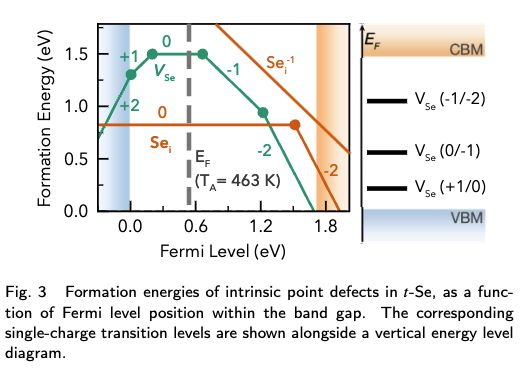

April 15, 2025 at 1:25 PM
We find interstitials to be very low energy due to a 'split-interstitial' geometry (found with doped & ShakeNBreak) and electrically neutral as a result, while vacancies are higher energy and have several charge states / in-gap defect levels
The doped.utils.configurations module has also been added, to quickly generate CC diagram structures / initial NEB paths for defect transformations, ensuring correct initial orientations (to give shortest linear path between defect geometries)

February 4, 2025 at 4:28 PM
The doped.utils.configurations module has also been added, to quickly generate CC diagram structures / initial NEB paths for defect transformations, ensuring correct initial orientations (to give shortest linear path between defect geometries)
CompetingPhases now compatible with both legacy and new Materials Project APIs, with automatic handling (and appropriate warnings) for cases of unstable host materials/compositions.
JSON serialization updates, faster & more convenient, more visualisation & plotting functions...
JSON serialization updates, faster & more convenient, more visualisation & plotting functions...

February 4, 2025 at 4:28 PM
CompetingPhases now compatible with both legacy and new Materials Project APIs, with automatic handling (and appropriate warnings) for cases of unstable host materials/compositions.
JSON serialization updates, faster & more convenient, more visualisation & plotting functions...
JSON serialization updates, faster & more convenient, more visualisation & plotting functions...
FermiSolver & ChemicalPotentialGrid; advanced defect/carrier thermodynamics w/various constraints (e.g. mobile/fixed defects, charge states etc)
Many convenience functions; scanning temp / chem potentials etc, optimising properties over many-dimensional chem pot space...
@agsquires.bsky.social 🙌
Many convenience functions; scanning temp / chem potentials etc, optimising properties over many-dimensional chem pot space...
@agsquires.bsky.social 🙌
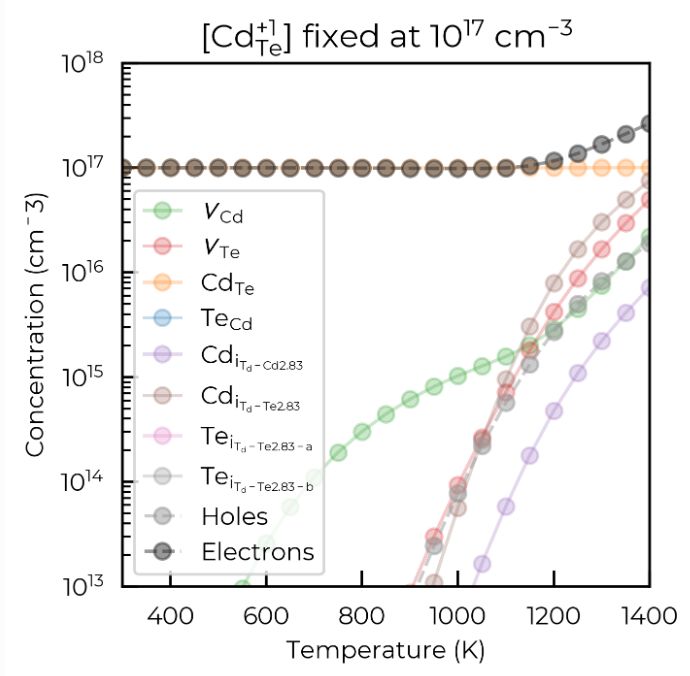

February 4, 2025 at 4:28 PM
FermiSolver & ChemicalPotentialGrid; advanced defect/carrier thermodynamics w/various constraints (e.g. mobile/fixed defects, charge states etc)
Many convenience functions; scanning temp / chem potentials etc, optimising properties over many-dimensional chem pot space...
@agsquires.bsky.social 🙌
Many convenience functions; scanning temp / chem potentials etc, optimising properties over many-dimensional chem pot space...
@agsquires.bsky.social 🙌
Efficient defect generation in 𝘢𝘭𝘭 Materials Project entries (arxiv.org/abs/2412.19330), incl nightmares like Na₆Zn₄Sn₄Si₃(S₃O₁₆)₃, demonstrates its efficiency & robustness!
-> defect (incl. interstitial) generation, oxi & charge state guessing, symmetry analysis...
-> defect (incl. interstitial) generation, oxi & charge state guessing, symmetry analysis...


February 4, 2025 at 4:28 PM
Efficient defect generation in 𝘢𝘭𝘭 Materials Project entries (arxiv.org/abs/2412.19330), incl nightmares like Na₆Zn₄Sn₄Si₃(S₃O₁₆)₃, demonstrates its efficiency & robustness!
-> defect (incl. interstitial) generation, oxi & charge state guessing, symmetry analysis...
-> defect (incl. interstitial) generation, oxi & charge state guessing, symmetry analysis...
The latest version of 𝙙𝙤𝙥𝙚𝙙 (and 𝑺𝒉𝒂𝒌𝒆𝑵𝑩𝒓𝒆𝒂𝒌), our defect modelling python packages, have been released!
Incl:
- Major efficiency updates
- Advanced defect/carrier thermodynamics w/custom constraints
- Auto shallow defect handling
- CC diagram generation
...🧵👇
Incl:
- Major efficiency updates
- Advanced defect/carrier thermodynamics w/custom constraints
- Auto shallow defect handling
- CC diagram generation
...🧵👇


February 4, 2025 at 4:28 PM
The latest version of 𝙙𝙤𝙥𝙚𝙙 (and 𝑺𝒉𝒂𝒌𝒆𝑵𝑩𝒓𝒆𝒂𝒌), our defect modelling python packages, have been released!
Incl:
- Major efficiency updates
- Advanced defect/carrier thermodynamics w/custom constraints
- Auto shallow defect handling
- CC diagram generation
...🧵👇
Incl:
- Major efficiency updates
- Advanced defect/carrier thermodynamics w/custom constraints
- Auto shallow defect handling
- CC diagram generation
...🧵👇
I find the MACE-mp universal potential to successfully predict preferences for split vacancy formation in the majority of cases.
This then allows an efficient tiered screening approach where I scan all compounds in the ICSD & Materials Project database for split cation vacancies
This then allows an efficient tiered screening approach where I scan all compounds in the ICSD & Materials Project database for split cation vacancies

January 6, 2025 at 1:25 PM
I find the MACE-mp universal potential to successfully predict preferences for split vacancy formation in the majority of cases.
This then allows an efficient tiered screening approach where I scan all compounds in the ICSD & Materials Project database for split cation vacancies
This then allows an efficient tiered screening approach where I scan all compounds in the ICSD & Materials Project database for split cation vacancies
This allows screening for split cation vacancies in a subset of stable metal oxide compounds (journals.aps.org/prmaterials/...), finding these defect configurations to be far more prevalent than previously known
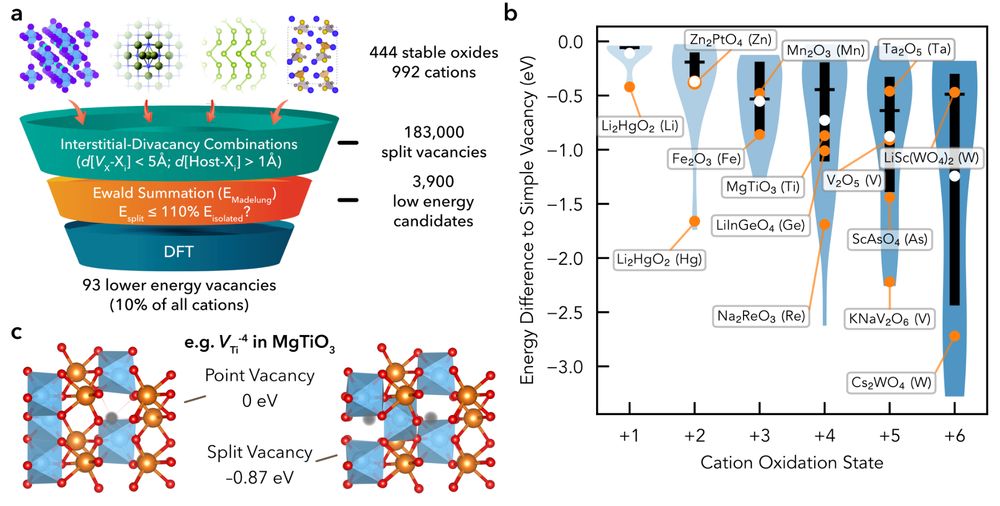
January 6, 2025 at 1:25 PM
This allows screening for split cation vacancies in a subset of stable metal oxide compounds (journals.aps.org/prmaterials/...), finding these defect configurations to be far more prevalent than previously known
But we also can't just brute force enumerate potential split vacancy configurations, as the search space is enormous (>1000s of candidate geometries per defect).
However, I find that electrostatic models can greatly reduce this space (as electrostatics dominate energetics here)
However, I find that electrostatic models can greatly reduce this space (as electrostatics dominate energetics here)


January 6, 2025 at 1:25 PM
But we also can't just brute force enumerate potential split vacancy configurations, as the search space is enormous (>1000s of candidate geometries per defect).
However, I find that electrostatic models can greatly reduce this space (as electrostatics dominate energetics here)
However, I find that electrostatic models can greatly reduce this space (as electrostatics dominate energetics here)
Vacancy defects can sometimes transform to split-vacancies, with dramatic changes in energy & behaviour, e.g. in Ga₂O₃ as serendipitously discovered by Joel Varley.
They have only been witnessed in a handful of cases however – are they inherently rare or have we just not had the tools to find them?
They have only been witnessed in a handful of cases however – are they inherently rare or have we just not had the tools to find them?

January 6, 2025 at 1:25 PM
Vacancy defects can sometimes transform to split-vacancies, with dramatic changes in energy & behaviour, e.g. in Ga₂O₃ as serendipitously discovered by Joel Varley.
They have only been witnessed in a handful of cases however – are they inherently rare or have we just not had the tools to find them?
They have only been witnessed in a handful of cases however – are they inherently rare or have we just not had the tools to find them?
ML can be powerful for understanding defects, but currently sufficient only in select cases
MLFFs (& geometric/electrostatic tools in doped) allow screening challenging 'non-local' defect reconstructions (split vacancies) in all ICSD/MP solids, w/caveats
arxiv.org/abs/2412.19330
#CompChem #chemsky
MLFFs (& geometric/electrostatic tools in doped) allow screening challenging 'non-local' defect reconstructions (split vacancies) in all ICSD/MP solids, w/caveats
arxiv.org/abs/2412.19330
#CompChem #chemsky

January 6, 2025 at 1:25 PM
ML can be powerful for understanding defects, but currently sufficient only in select cases
MLFFs (& geometric/electrostatic tools in doped) allow screening challenging 'non-local' defect reconstructions (split vacancies) in all ICSD/MP solids, w/caveats
arxiv.org/abs/2412.19330
#CompChem #chemsky
MLFFs (& geometric/electrostatic tools in doped) allow screening challenging 'non-local' defect reconstructions (split vacancies) in all ICSD/MP solids, w/caveats
arxiv.org/abs/2412.19330
#CompChem #chemsky



